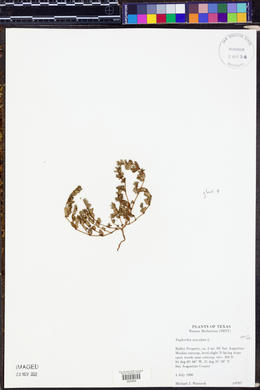Euphorbia maculata
|
|
|
|
Family: Euphorbiaceae
Spotted Sandmat, more...prostrate spurge, large spurge, spotted spurge, spotted sandmat
[Chamaesyce maculata (L.) Small, moreChamaesyce mathewsii Small, Chamaesyce supina (Raf.) Moldenke, Chamaesyce tracyi Small, Euphorbia maculata var. detonsa Engelm. ex Boiss., Euphorbia meganaesos , Euphorbia supina Raf.] |
Wiggins 1964, Jepson 1993, Kearney and Peebles 1969 Duration: Annual Nativity: Native Lifeform: Forb/Herb General: Prostrate annual, with pubescent stems to 45 cm long. Leaves: Elliptic to oblong, 4-17 mm, serrulate to entire, often bearing 1-2 red spots on upper surface, tip acute to obtuse; stipules separate, fringed. Flowers: Dense, on short lateral branches, involucres obconical, 0.7-0.9 mm in diameter, sparsely villous; glands transversely elliptical, about 0.2 mm long; narrow appendages, about equaling or slightly surpassing width of glands, white, crenulate along distal margins; usually 4-5 staminate flowers per cyathia; pistillate flower with style divided less than half the length. Fruits: Capsule sharply 3-angled, 1.2-1.4 mm long, pubescent to subglabrous. Ecology: Found in disturbed areas from 1,000-5,500 ft (305-1676 m); flowers June-October. Notes: In fruit the evenly strigose capsule helps to distinguish this species. Ethnobotany: Used as a cancer treatment, as a purgative, rubbed on skin eruptions, or for sores or sore nipples, for postpartum bleeding, as a toothache remedy, the root is taken for urinary diseases, or other venereal diseases, taken to purify the blood, as a wash for cuts, an eye wash, and for bee stings and sores. Etymology: Euphorbia is named for Euphorbus, Greek physician of Juba II, King of Mauretania, while maculata means spotted, referring to the purple spots on the stem, leaves, and petals. Synonyms: Chamaesyce mathewsii, Chamaesyce supina, Chamaesyce tracyi, Euphorbia maculata, Euphorbia supina Editor: SBuckley, 2010 Milk-purslane; spotted s. Annual; stems prostrate or nearly so, to 4 dm, often forming circular mats, sparsely to densely villous or villous-puberulent; lvs dark green, often with a red spot, oblong or ovate-oblong to linear-oblong, mostly 5-15 mm and a third to half as wide, often widest below the middle; involucre cleft on one side a fourth to a third of its length; ovary and fr strigose, the fr 1,5 mm; styles 0.3-0.4 mm, bifid a fourth to a third their length; seeds quadrangular, 1 mm, nearly smooth or with a few inconspicuous transverse ridges, becoming mucilaginous when wet; 2n=28. Very abundant as a weed in lawns, gardens, and waste places, also in meadows and open woods; Que. to N.D., s. to Fla. and Tex., and intr. as a weed elsewhere in the world. June-Sept. (E. supina; Chamaesyce m.) Gleason, Henry A. & Cronquist, Arthur J. 1991. Manual of vascular plants of northeastern United States and adjacent Canada. lxxv + 910 pp. ©The New York Botanical Garden. All rights reserved. Used by permission. Plant: Annual; stem prostrate, hairy, branches alternate; sap milky Leaves: cauline, opposite, short-petioled, 4-17 mm; stipules separate, fringed; blade ovate to oblong, hairy or becoming glabrous, tip acute to obtuse, margin finely toothed INFLORESCENCE: flower-like, generally 1 per node, dense on short, lateral branches; involucre < 1 mm, obconic, hairy; gland < 0.5 mm, elliptic; appendage width = gland width, scalloped, white to pink Flowers: Staminate flowers 4-5, generally in 5 clusters around pistillate flower, each flower a stamen; Pistillate flower: 1, central, stalked; ovary chambers 3, ovule 1 per chamber, styles 3, divided < 1/2 length Fruit: capsule, < 1.5 mm, ovoid, lobed, hairy; Seed < 1.5 mm, ovoid, transversely wrinkled, light brown Misc: Waste places, gardens; < 200 m.; Apr-Oct From Flora of Indiana (1940) by Charles C. Deam A frequent weed in both moist and dry soils in all parts of the state. Mostly in fallow fields and cultivated grounds; also along roadsides and railroads, in pastures and open woodland, and on the banks of streams. ...... Indiana Coefficient of Conservatism: C = 0 Wetland Indicator Status: FACU |




































































































